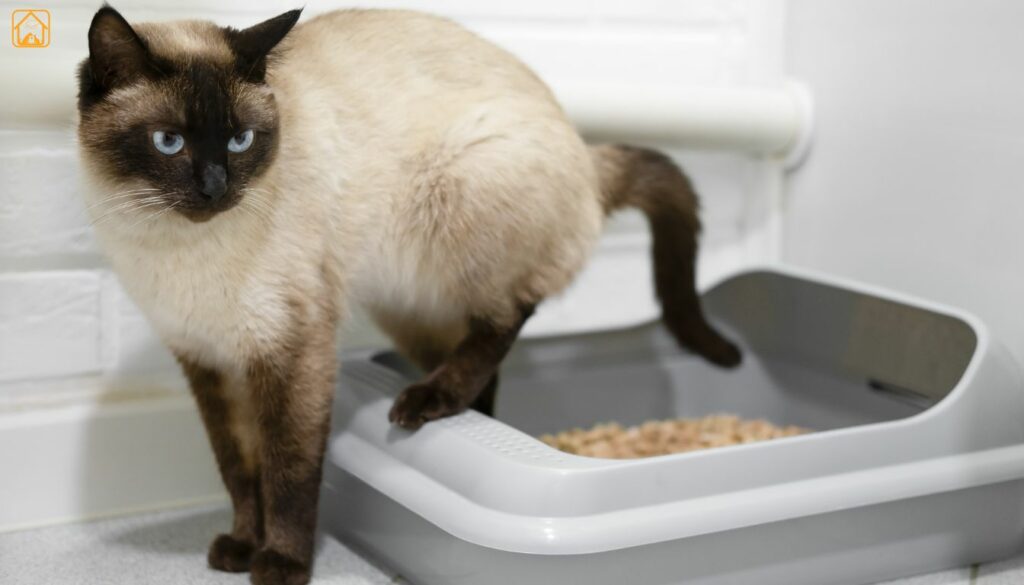When to Start Litter Training Your Kitten
Kittens usually start learning bathroom habits from their mom, but when you adopt, you’ll want to know the right time to begin. Most kittens are ready for cat litter training around 3-4 weeks old. At this age, they can walk steadily and are naturally inclined to dig in sand-like materials. This makes it the perfect age to introduce a small, shallow litter box with unscented, non-clumping litter.
I remember my first rescue kitten, Willow, figured it out in just a few days at four weeks old. Timing is everything, start too early, and your kitten may not physically be ready. Wait too long, Wait too long, and they might start going in the wrong places out of habit. If you’re wondering when to start litter training kittens, aim for that sweet spot just as they’re transitioning from mother’s milk to solid food.
Essential Supplies for Litter Training Kittens
To litter train your kitten smoothly, you’ll need the right tools from the start. Below are some essential tools you need.
- Low-sided litter box: Easy for small kittens to enter and exit.
- Kitten-safe litter: Unscented litter for kittens is best, avoid strong perfumes or clumping types for very young kittens.
- Litter scoop: For quick cleanups to keep the box fresh.
- Litter mat (optional): Helps contain any stray grains outside the box.
- Kitten treats: For positive reinforcement after successful litter use.
- Kitten-friendly enzymatic cleaner: For cleaning up accidents and removing odors.
Having these supplies before you start makes everything less stressful. Stock up, and you’ll feel prepared, trust me, scrambling for supplies with a kitten in your arms is no fun.
Step-by-Step Guide: How to Litter Train a Kitten Fast
Here’s a simple, step-by-step guide on how to litter train a kitten using patience, consistency, and a lot of love. Training might feel like a handful at first, but it gets easier with the right steps.
- Introduce the box: Start by letting your kitten sniff and explore the litter box. Place it in a quiet, easy-to-reach spot and bring your kitten to it several times a day, especially after waking up or eating. This helps them become familiar with it.
- Place them in the box: Right after meals, naps, or if your kitten looks like they’re searching for a bathroom spot by sniffing or crouching, gently place them in the litter box. It teaches them this is the right place to go.
- Encourage digging: Use your finger to scratch the surface of the litter lightly. Kittens are natural mimics, and this simple action often encourages them to dig and go on their own.
- Be patient with accidents: Accidents will happen, don’t panic or punish. Clean any messes with an enzymatic cleaner to remove the scent, so they don’t return to the same spot. Then, calmly take them back to the litter box.
- Reward immediately: Give your kitten a treat or some soft praise immediately after they use the box. Quick rewards help them connect good behavior to a positive experience.
- Keep boxes clean: Scoop out waste after every use, especially during the training days. A clean box encourages your kitten to return. Dirty boxes can push them away.
- Watch for signs: If your kitten starts circling or acting restless, gently lead them to the box. You’ll be surprised how fast they catch on with kindness and routine.
Honestly, the first few days can feel like a full-time job, but it pays off. The secret is consistency and kindness, never punishment.
Choosing the Right Litter and Litter Box for Kittens
Picking the Perfect Litter
Choosing the right litter and litter box is a big step in helping your kitten learn quickly and comfortably. When it comes to litter, go with unscented, non-clumping options at first. Young kittens often explore with their mouths, and clumping litter can be dangerous if swallowed. Unscented litter is also gentler on their little noses and encourages them to use the box without hesitation. As your kitten grows, you can slowly try clumping varieties if you prefer.
Litter Box Size and Style
For the litter box, pick one that’s small and low-sided, something around 13 x 9 inches is perfect. Kittens can get overwhelmed by large or tall boxes, so keep it simple. Some kittens like open trays where they can see everything, while others enjoy a bit of privacy. You can try both to see what your kitten likes best.
For multi-cat households, always have at least one more box than the number of cats. This helps prevent disputes and accidents.
Litter Box Placement and Creating a Litter Routine
Smart Placement Strategies
Getting the litter box placement right makes training much easier. Choose a quiet, calm area your kitten can reach easily, somewhere safe but not completely out of sight. Avoid putting it near loud appliances like washing machines or in dark corners. Your kitten should feel comfortable, not scared, when using the box.
- Place a box on each floor for multi-level homes.
- Keep boxes away from food and water bowls.
- Make sure there’s a little light, especially at night.
Establishing a Kitten Litter Training Schedule
To build a solid routine, take your kitten to the litter box right after meals, naps, or active play sessions, these are the times they usually need to go. Doing this consistently helps your kitten form good habits quickly. With patience and a regular schedule, your kitten will learn to use the litter box on their own in no time.
Positive Reinforcement & Reward Strategies
Positive reinforcement kitten litter training really is the magic ingredient. Always reward your kitten immediately after they use the box, treats, praise, or a favorite toy all work. Ignore accidents, but be quick with praise for wins. This creates a strong, happy association for your kitten.
Some pet parents like to use a cat litter training spray or litter attractant for kittens, which can help encourage use. Just make sure any product is safe for kittens and used as directed.
Over time, you can fade out treats as your kitten’s routine becomes second nature.
Troubleshooting: Common Litter Training Mistakes and Solutions
- Box too hard to reach: Make sure the litter box is placed in an easy-to-find, quiet spot. If it’s hidden or on a different floor, your kitten may not make it in time.
- Litter type issue: Some kittens dislike strong scents or rough textures. Switch to an unscented, soft, non-clumping litter to make it more inviting.
- Dirty box: Scoop the litter box at least once or twice daily. A single dirty visit can make your kitten avoid the box next time.
- Too few boxes: If you have more than one cat, always provide one box per cat plus one extra. This helps avoid crowding and territorial issues.
- Stress or fear: Loud sounds, heavy foot traffic, or bullying from other pets can cause litter avoidance. Move the box to a calm, low-stress area where your kitten feels safe.
If problems persist, try a different litter, add privacy like a partial cover, or use a pheromone diffuser to reduce stress. And if you ever worry about health issues, don’t hesitate to call your vet for advice.
How to Litter Train Older or Stray Cats
Wondering how to train an older cat to use a litter tray or how to litter train a stray cat? It’s never too late, but it can take a little more time and patience. Use the same basic steps as for kittens, but pay extra attention to:
- Accessibility, older cats might need lower sides.
- Privacy, a quiet, safe spot is crucial for shy or stray cats.
- Gradual introductions, confined to a small area at first, with the box nearby.
When is it too late to train a cat? Rarely ever! Even adult cats learn, though habits may take a few weeks to change. If your cat resists, rule out medical issues and keep sessions positive. Sometimes, a cat litter training spray or attractant can help in tough cases.
FAQs About Kitten Litter Training
When to start litter training kitten?
Most kittens are ready for litter training at 3-4 weeks old, just as they begin exploring and weaning. Start then for the fastest, least stressful results.
What’s the best litter for kittens?
Unscented, non-clumping litter is safest for kittens under 8 weeks, since curious kittens might taste it. Once older, you can try clumping types if you prefer.
How to get a cat to use a litter box for the first time?
Place your kitten or cat gently in the box after meals or naps, and reward them when they use it. Most catch on quickly with patience and positive reinforcement.
How to reward kitten litter use?
Give a treat, gentle praise, or a favorite toy immediately after your kitten uses the litter box. This helps them associate the box with good things.
When is it too late to litter train a cat?
It’s almost never too late! Older cats and even strays can learn to use a litter box, though it may take longer. Stay consistent and positive, and see your vet if problems persist.
Should I use a litter attractant or cat litter training spray?
Some kittens respond well to these products. Choose a kitten-safe formula and use as directed. They can be especially helpful for stubborn cases.
When to call the vet for litter issues?
If your kitten or cat suddenly stops using the box, seems to strain, or has accidents despite all efforts, call your vet. Medical issues like urinary tract infections can cause litter problems and need prompt care.
Conclusion
Helping your kitten master the litter box takes a little effort, but the rewards are huge. With patience, the right setup, and lots of love, your kitten will soon be a litter pro, and your home will stay cleaner and happier for it.



